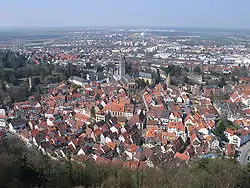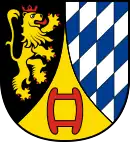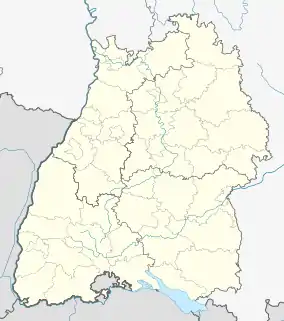Weinheim
![]() Weinheim is a town with about 43,000 inhabitants in northwest Baden-Württemberg, Germany. It is in the Rhine-Neckar Metropolitan Region, approximately 15 km (9 mi) north of Heidelberg and 10 km (6 mi) northeast of Mannheim. Weinheim is known as the "Zwei-Burgen-Stadt", the "town of two castles", after two fortresses overlooking the town from the edge of the Odenwald in the east.
Weinheim is a town with about 43,000 inhabitants in northwest Baden-Württemberg, Germany. It is in the Rhine-Neckar Metropolitan Region, approximately 15 km (9 mi) north of Heidelberg and 10 km (6 mi) northeast of Mannheim. Weinheim is known as the "Zwei-Burgen-Stadt", the "town of two castles", after two fortresses overlooking the town from the edge of the Odenwald in the east.
Weinheim | |
|---|---|
 Panorama of Weinheim from the south-east | |
 Coat of arms | |
Location of Weinheim within Rhein-Neckar-Kreis district  | |
 Weinheim  Weinheim | |
| Coordinates: 49°33′N 08°40′E | |
| Country | Germany |
| State | Baden-Württemberg |
| Admin. region | Karlsruhe |
| District | Rhein-Neckar-Kreis |
| Subdivisions | Town centre and 10 quarters |
| Government | |
| • Lord mayor | Manuel Just (SPD) |
| Area | |
| • Total | 58.11 km2 (22.44 sq mi) |
| Elevation | 135 m (443 ft) |
| Population (2019-12-31)[1] | |
| • Total | 45,425 |
| • Density | 780/km2 (2,000/sq mi) |
| Time zone | UTC+01:00 (CET) |
| • Summer (DST) | UTC+02:00 (CEST) |
| Postal codes | 69469 |
| Dialling codes | 06201 |
| Vehicle registration | HD |
| Website | www.weinheim.de |
Geography
Weinheim is situated on the Bergstraße theme route on the western rim of the Odenwald. The old town lies in the valley, with the new part of town further to the west. The Market Square is filled with numerous cafes, as well as the old Rathaus (guildhall). Further to the south is the Schlossgarten (Palace Garden) and the Exotenwald (Exotic Forest), which contains species of trees imported from around the world, but mostly from North America and Japan.
History
Weinheim celebrated its 1250th anniversary in 2005.
The earliest record of Weinheim dates back to 755 CE, when the name "Winenheim" was recorded in the Lorsch codex, the record book of Lorsch Abbey.
In 1000, Emperor Otto III bestowed on Weinheim the right to hold markets, and in 1065 the right to mint and issue coins. A new town developed next to the old town from 1250. In 1308, the old town was transferred to the Electorate of the Palatinate. From 1368 the whole town belonged to the Electorate of the Palatinate, and since the end of the 14th century to the Heidelberg Oberamt district. With the transfer to Baden in 1803, Weinheim became the seat of its own Amt, which was unified with Landkreis Mannheim in 1936. From 1938 onwards Weinheim belonged to Landkreis Mannheim until January 1, 1973, when the Rhein-Neckar-Kreis was formed.
A Jewish community in Weinheim is first recorded in 1228. There were persecutions in Weinheim in 1298 (Rintfleisch massacres) and 1348–49 (Black Death persecutions). The Jews were expelled from Weinheim in 1391. The Weinheim Jewish community began to grow again in the Thirty Years' War. There was a synagogue, a beth midrash, and a mikveh, and, in the 19th century, a school for boys and a teacher-training college. The synagogue was destroyed in the Kristallnacht (9–10 November 1938) and the last few Jews sent to Gurs on 22 October 1940.[2]
Local attractions

- Windeck Castle, originally built around 1100 to protect the Lorsch monastery; it was badly damaged in the Thirty Years' War and again by Louis XIV of France in the Nine Years' War.
- Wachenburg Castle, built between 1907 and 1928 by German Student Corps fraternities; the annual convention of the Weinheimer Senioren-Convent is held at the Wachenburg.
- The Market Square
- The Schloss, home of the town council
- Gerberbach Quarter, old haunt of the leather makers
- Schlosspark
- Waidsee Lido (Strandbad Waidsee), swimming beach on the Waidsee artificial lake
- Miramar (Weinheim) thermal spa and sauna complex, next to the Waidsee lake
- Exotenwald Weinheim, a forest arboretum
- Schau- und Sichtungsgarten Hermannshof, a botanical garden
Museum
Weinheim's town museum occupies what used to be the local headquarters of the Teutonic Order and holds exhibits about Weinheim and its surroundings: archaeology from the prehistoric through to the Merovingian dynasty, the highlight of which is the Nächstenbach bronze hoard of 76 objects from the late Bronze Age; displays documenting the Medieval and modern social history of the town and works from contemporary artists.
Events
- February: High-jump Gala, with world class high-jumpers
- March: the Sommertagszug, a festival celebrating the coming of summer.
- May/June (near Ascension Day): day of the Weinheimer Senioren-Convents
- June–August: Weinheim's summer of culture
- June: Scheuerfest (barn party) in Ritschweier
- July: the Weinheim road race
- May–September: Kerwes in Rippenweier, Sulzbach, Lützelsachsen, Oberflockenbach und Hohensachsen
- August (second weekend thereof): Weinheim's Kerwe (Friday to Monday)
- September (first Friday-Sunday): Weinheimer UKW-Tagung, a three-day international amateur radio meeting held annually since 1956[3]
- October: Bergsträßer Winzerfest (lit. "mountain-road vintner festival") in Lützelsachsen
Local businesses
- Beltz Verlag
- Freudenberg Group
- Schlegel und Partner GmbH
- Kukident GmbH, Reckitt Benckiser AG
- Naturin
- OAGIS
- T-Systems ITS GmbH
- Wiley-VCH publishers
- 3 Glocken
- Weinheimer Nachrichten
- Druckhaus Diesbach
- SAP SE
- Domaniecki Carpetence
- DLCON
Transport
Trains
Weinheim has two main train stations on the Main-Neckar Railway, these being Weinheim (Bergstraße) station (served by Regional and long-distance IC trains) and Lützelsachsen (served by Regional trains). These provide connections to Frankfurt, Hamburg and other destinations within Germany.
Weinheim is also served by the OEG tramway, which is used daily by people who use this to commute to the cities of Mannheim and Heidelberg.
International relations
People
Population over time
These are the population figures for particular years. There are drawn from guesses, 'Volkszählungsergebnisse (semi-official figures, demarcated by a ¹) and official statistics based on place of residence (Hauptwohnsitz).
|
|
¹ These are taken from a Volkszählungsergebnes.
Honorary citizens
The town of Weinheim has made the following people honorary citizens (Ehrenbürger):
- 1894: Carl Johann Freudenberg, Geheimer Kommerzienrat (royal economist)
- 1904: Erhard Bissinger, Consul general
- 1913: Aute Bode, chief engineer and the architect behind the Wachenburg
- 1918: Hermann Ernst Freudenberg, Geheimer Kommerzienrat (royal economist)
- 1922: Georg Friedrich Vogler, vice-mayor
- 1923: Adam Karrillon, doctor and author
- 1928: Emil Hartmann, construction engineer
- 1928: Prof. Arthur Wienkoop, Architect
- 1933: Paul von Hindenburg, German President[5]
- 1940: Georg Peter Nickel, agriculturist
- 1949: Richard Freudenberg, factory owner
- 1953: Hans Freudenberg, factory owner
- 1954: Sepp Herberger, sports trainer, trainer of the German World Cup winning side of 1954
- 1962: Wilhelm Brück, Lord Mayor
- 1986: Theo Gießelmann, Lord Mayor
- 2004: Dieter Freudenberg, factory owner
- 2004: Wolfgang Daffinger, mayor, representative in the Landtag
- 2005: Uwe Kleefoot, Lord Mayor
Sons and daughters of the town
- Friedrich Rauch (1786–1829), colonel who fought and died in Argentina
- Heinrich Hübsch (1795–1863), head of public works
- Karl Seidenadel (1829–1894), translator of Greek works
- Philipp Bickel (1829–1914), baptist theologian and publisher
- Friedrich August Bender (1847–1926), chemist and entrepreneur
- Wilhelm Platz (1866–1929), factory owner and author
- Richard Freudenberg (1892–1975), DDP MP, MdB, for a long time one of the town's aldermen and benefactors
- Erwin Linder (1903–1968), actor and voice actor
- Heidi Mohr (born 1967), national football player
- Ralf Sonn (born 1967), high jumper
- Markus Kuhn (born 1986), currently plays for the NY Giants in the NFL
People who worked in the town
- Ingrid Noll (born 1935), writer (e.g. "Die Apothekerin"), lived in Weinheim.
- Karl Friedrich Bender (1806–1869), theologian, teacher, principal of the Erziehungsanstalt für Knaben (boys' school)
References
- "Bevölkerung nach Nationalität und Geschlecht am 31. Dezember 2019". Statistisches Landesamt Baden-Württemberg (in German). September 2020.
- "Die Synagoge in Weinheim (Rhein-Neckar-Kreis)". Alemannia-judaica.de. Retrieved 29 December 2019.
- https://ukw-tagung.org/historisches/
- "Städtepartnerschaften". weinheim.de (in German). Weinheim. Retrieved 2019-12-02.
- For those made honorary citizens in 1933, see Heinz Keller: Weinheim 1933-1945 − Zeitskizzen. in: Stadt Weinheim (Hrsg.): (in German)Die Stadt Weinheim zwischen 1933 und 1945. (= Weinheimer Geschichtsblatt Nr. 38), Weinheim 2000, ISBN 3-923652-12-7, S. 13f.
External links
| Wikimedia Commons has media related to Weinheim. |
| Wikivoyage has a travel guide for Weinheim. |